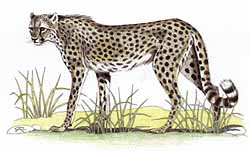English: Cheetah or Hunting Leopard; French: Guépard; Afrikaans: Jagluiperd; Afghan: Pedar plang; Amharic: Abushemane; Arabian: Fahad; Brahni: Yioz; Canarese: Chircha, Sivungi; Damara: arub, noeb; Hausa: rabbi; Herero: Ozjitotongue; Hindi: chità; Iran: Yuz palang; Kiswahili: Msongo, Duma; Kung: gao; Kuanyama: Eyuku; Lozi: Linau; Maasai: Okinyalasho; Mekrani: gurk; Nepali: cheetah; Ovambo: Eshinga; Pashto: Peedar plang; Russian: Gepard; Shangan: Dzimba; Shona: Didingwe; Shosa: Ihlozi; Sindebele: Hlosi; Sotho: Lengau; Tswana: Ihlose; Tuareg: Amaias; Turkish: Cheetah; Urdu: Cheetah; Wolof: Siho; Zulu: Ihlozi, Ingulule.
 |
Former distribution: Africa, north and south of the Sahara to Nigeria, Sudan, Somalia, Kenya, south to South Africa (not in tropical rain forest countries), central India, Rajastan, Gujarat, Sind, Afghanistan, Pakistan, Egypt, Arabia, Iran, Iraq, Syria, Jordan, Israel, USSR, Turkmeniya, Uzbekistan, Tadzhikistan and Transcaucasia.
Present distribution: Severely reduced due to expanse of human populations. South of the Sahara from Nigeria, Sudan, Somalia to southern Africa; Iran and Turkmeniya/Afghan border.
Behaviour: Preferred habitat: open, semi-arid grassland, savannas, open woodlands and steppes: activity predominantly diurnal; they hunt singly or in small family groups different prey including gazelles, antelopes, hares, birds, occasionally young zebras, warthogs and young ostriches. Cheetahs are the fastest runners of all cats.
Population status: Vulnerable and in some regions stable. Total population is estimated at 25-30 000. The new figures from Namibia suggest such numbers. (4000, pers. comm. HERRIGEL 1988) Reintroductions into national parks in East and South Africa were successful. Protection by law also helped to increase or stabilise rare populations in some regions. Probably extinct in India, Saudi Arabia, Jordan, Israel, Uzbekistan and Tadzhikistan.
Brief notes:
Body weight: 40-72 kg
Head and body length: 112-135 cm
Tail length: 65-85 cm
Shoulder height: 76-85 cm
Gestation period: 90-96 days
Maximum age: 15 years, 17 years in captivity
Trophy: Skull record RW’s: 14 1/2″, 1978, Transvaal, RSA.J. GOROSTIDI; average 12 1/1″. CIC: 35.1 points, South Africa; average 26. SCI: 15″, 1983 Namibia, JAN OELOFSE; average 11″.
Hunting methods: Stalking, on horseback. Protected by law in the USSR and Iran.
Subspecies: 2 (1 Afro-tropical region, 1 Palaearctic)
1. African Cheetah Acinonyx j. jubatus (Schreber, 1766) Stable and vulnerable.
2. Acinonyx j. venaticus USSR; Turkmeniya, Uzbekistan, Tadzhikistan, Transcaucasia and the Afghanistan border, probably in southern Iran? Iraq to Syria, Jordan, Israel, Lebanon, along North Africa to Rio de Oro. Endangered, USSR: 10, Iran: 15? Probably extinct in India.
Remarks: The author recognizes only 2 subspecies; Palaearctic, Acinonyx j. venaticus and Afro-tropical region, Acinonyx j. jubatus; the king cheetah, (A. j. rex) is considered as a mutation, (acc. to MCDONALD 1984). The drastic decrease to near or complete extinction is mainly caused by the overhunting of its prey, such as gazelles and the blackbuck-antelope with motor vehicles. A reintroduction of Cheetahs into its former range should be planned. A.j. jubatus is steadily declining in Africa, with the exception of Namibia. The increase in numbers in Namibia forced the game control office to open hunting again. The Cheetah populations in the Palaearctic are generally threatened with extinction, due to the overhunting of Cheetahs and their principal prey, the gazelles. More information required on population status and distribution. Full protection is urgently needed.






